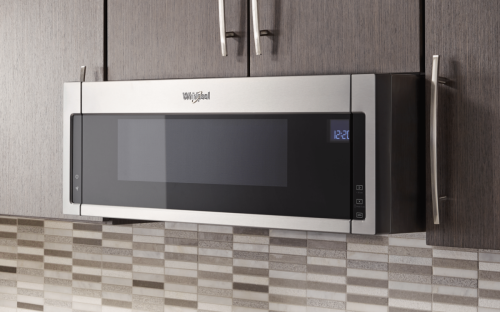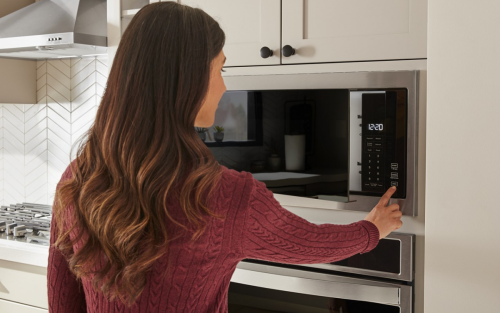
History of the microwave oven
Microwaves are a staple of modern kitchens and make everything from meal prep to snack time quick and convenient. Read this guide to learn more about the invention of the modern microwave, discover its original purpose and find out what today’s microwaves can do to make your family’s routine easier.
When was the microwave invented?
According to the American Physical Society, self-taught engineer Percy Spencer filed the first patent for the microwave oven in 1945. Spencer noticed a candy bar in his pocket melting rapidly as he worked with a live radar set emitting microwave signals, then discovered the radar’s compact cavity magnetron tube was responsible for heating the chocolate.
He experimented with heating foods by directing the magnetron tube toward things like popcorn and eggs, then went on to create a metal box to contain the microwaves with an opening where the magnetron tube could poke through. Spencer added a door to the metal box and a rough model of the modern microwave was born.
Who invented the first microwave?
American engineer Percy Spencer invented the first microwave, but he didn’t set out to create this modern convenience and kitchen staple we know and love today. Spencer helped develop a system to mass produce compact cavity magnetrons—the core component of a microwave—for Raytheon Laboratories during World War II.
He discovered the food heating capabilities of the compact cavity magnetron by accident, but soon began running experiments and working with Raytheon Laboratories to create the modern microwave oven.
What was the microwave originally made for?
The compact cavity magnetron tube is at the core of microwave oven technology and was first invented in 1940 at Birmingham University in England. The tube was originally used to emit radar signals that could detect enemy aircraft and ships during World War II, but in 1945, American engineer Percy Spencer accidentally discovered its capacity for quickly heating foods.
When did microwaves become popular?
Residential microwaves climbed in popularity throughout the 1970s and, by 1986, roughly one in four American homes owned a microwave oven. By 1997, the U.S. Bureau of Labor Statistics reported that nine of every ten American homes had a microwave.
Though invented in 1946, early microwave ovens were costly to manufacture, incredibly large and only sold to commercial establishments. The first microwave ovens landed in restaurants, ship galleys and canteens in 1946 weighing over 750 pounds, standing almost six feet tall and costing nearly $5,000. The first residential countertop microwaves—like these models from Whirlpool brand—started selling in 1967 for just under $500. Then, in the 1970s, cheaper parts and technological advancements brought prices down and triggered a surge in microwave purchases across the country.
What can microwaves do now?
Modern microwaves are available in a variety of sizes, configurations, power levels and feature sets. Select models from Whirlpool brand, for instance, include advanced features like Grill Mode, Steam Cooking and Air Fry Mode that let you sear, steam fish or vegetables and crisp foods right in the microwave.
Conventional microwaves typically include a Defrost feature and presets like Potato or Popcorn, but top-of-the-line models may also incorporate an extra heating element and fan for Convection cooking or smart technology to monitor cooking from connected devices.
Microwave oven history: a timeline
1940: Physicists John Randall and Harry Boot invent the cavity magnetron tube—the core component of a microwave—at Birmingham University in England. The cavity magnetron tube was used to detect enemy aircraft and ships during World War II.
1945: American engineer Percy Spencer notices a candy bar melting in his pocket while operating the magnetron tube and experiments further with corn kernels, then files the first patent for a rough version of the modern microwave.
1946: The first commercial microwave—the RadaRange— is sold by Raytheon to restaurants, large canteens and ships’ galleys. It was nearly six feet tall, weighed more than 750 pounds, used about 3,000 watts of power and sold for roughly $5,000.
1967: The first microwave for residential use comes to market. The countertop microwave, sold by Amana, used 115 watts of power and cost just under $500 at the time.
1970s: Microwave parts become cheaper and technological improvements help reduce the cost of residential microwaves, leading to a surge of microwave purchases.
1986: Statistics indicate 25 percent of all American households own a microwave oven.
- 1997: Statistics indicate 90 percent of all American households own a microwave oven.
Explore Whirlpool® microwaves
You can find the right Whirlpool® microwave to complement your kitchen’s layout with over-the-range, countertop, low profile and built-in models to choose from. Take advantage of Sensor Cooking on select models that automatically tracks cooking progress and adjusts cook times accordingly. Or shop models with Air Fry Mode that can crisp dishes like fries, chicken nuggets and more right in the microwave.
Learn more about microwave with Whirlpool brand
-
 How Do Microwaves Work to Cook Your Food? How do microwave ovens work to cook and heat food? Are microwaves safe? Learn more about this popular kitchen appliance with this guide from Whirlpool.
How Do Microwaves Work to Cook Your Food? How do microwave ovens work to cook and heat food? Are microwaves safe? Learn more about this popular kitchen appliance with this guide from Whirlpool. -
 Tips for Using a Microwave, Power Levels & Settings Cooking food in a microwave is fast and convenient. Learn how to change the power level on your microwave and other tips for getting great results.
Tips for Using a Microwave, Power Levels & Settings Cooking food in a microwave is fast and convenient. Learn how to change the power level on your microwave and other tips for getting great results. -
 What Are the Parts of a Microwave? A microwave is an essential cooking appliance for busy schedules. Learn about the different parts of a microwave to streamline meal prep even more.
What Are the Parts of a Microwave? A microwave is an essential cooking appliance for busy schedules. Learn about the different parts of a microwave to streamline meal prep even more.


home heartbeat
Ready for more tips, home hacks and appliance guides?












